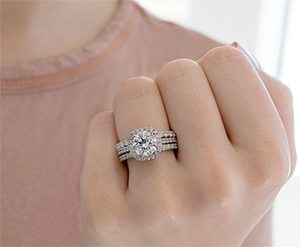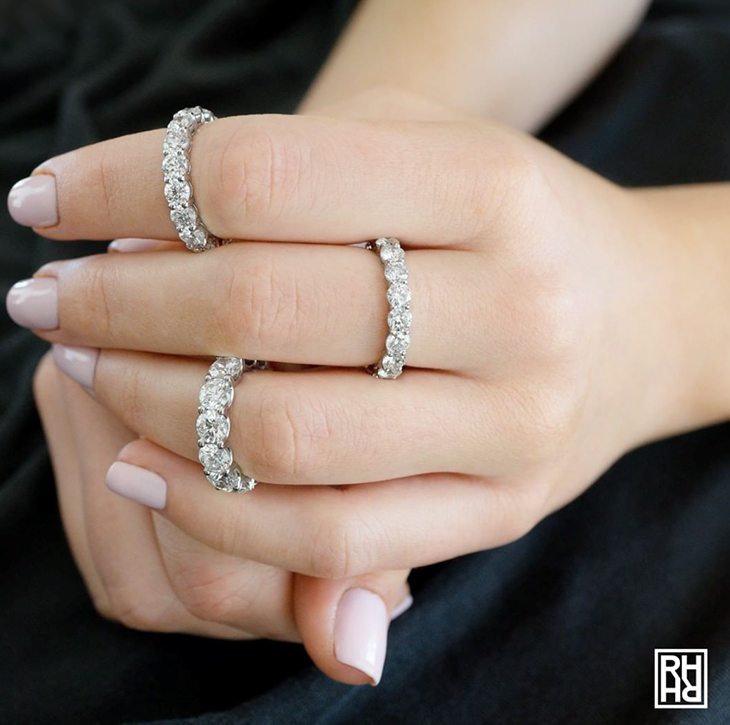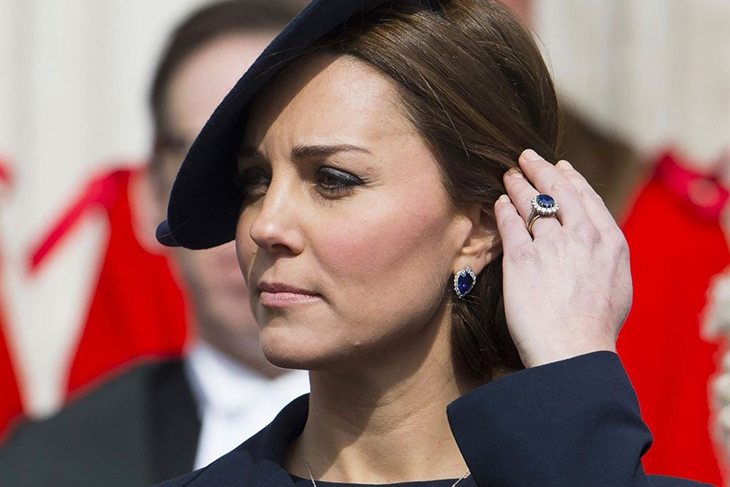
The Stylish Woman’s Wedding Ring Buying Guide
Your wedding ring is a shining symbol of your wedding vows. Since you’ll be wearing it every day for the rest of your life, it becomes part of you. Whether it’s a simple band of gold or an endless circle of diamonds, the right wedding ring complements your engagement ring and expresses your style as well as your commitment.
Should you choose an eternity ring? Or a shadow band? Or a traditional wedding band? We are here to walk you through the options so you can shoose the ring that suits you and your engagement ring best.
Choosing a Wedding Ring Metal

The first choice to make is the metal of your wedding band. To match or not to match, that is the question. The days when wedding rings always matched the engagement ring are over. (And couples today don’t usually wear his and hers matching bands either.) Today, your wedding band is as much an expression of style as your engagement ring.
The choice of your wedding ring is now an opportunity to customize the look of your engagement ring. If you love rose gold but your engagement ring is platinum, you can add a touch of rose with the wedding band. If your engagement ring is simple but you love vintage details, you can add that romantic feeling with your wedding ring.
A yellow gold band adds warmth to a white gold engagement ring setting. A platinum diamond wedding band sets off a yellow gold engagement ring setting. Think of your engagement ring and wedding ring as an opportunity for creative stacking.
No matter which metal you choose for your wedding ring, make sure it is responsibly sourced. At RockHer, all the gold and platinum in our wedding rings is recycled. (We are an industry leader in transparent diamond sourcing too.)

Buying an Eternity Wedding Ring
The most luxurious wedding band is the endless circle of diamonds around your finger known as a diamond eternity ring. The diamond eternity ring is a sparkling celebration of forever, symbolizing never-ending love. There are many names for this circle of diamonds: eternity ring, eternity band, infinity ring, celebration ring, diamond wedding ring, and full diamond band. The eternity ring is the perfect symbol for wedding vows.
There’s a wide variety of options for eternity ring styles. The most common is a pave eternity ring setting, which is most often used for delicate eternity rings that match the band of your engagement ring. In this ring setting, which is most often used for small diamonds, the diamond is set into the metal and prongs are pushed over the stone from the sides.

A split prong eternity ring setting has four separate prongs that branch from the base of the ring to grasp each diamond. It lets more light in than the pave setting, resulting in more sparkle.
Shared prong eternity rings, also sometimes called U-shape eternity bands, have prongs that are shared between two diamonds, scooped out to allow lots of light to enter from the side of each diamond.
If you prefer more metal around each stone, in channel set eternity bands, the diamonds are held in a channel between bars of metal that go around the ring finger. The gems can be held in place from behind or have small pave prongs in front. Although the extra metal protects the diamonds it also blocks some light. In bezel set eternity bands, each diamond is held in an individual metal frame, giving the ring a sleek modern look and also protecting the stone.
Although round diamonds are the most popular choice for eternity bands, other diamond shapes can be quite beautiful also. In particular, princess cut eternity bands, Asscher cut eternity bands, radiant cut eternity bands, baguette diamond eternity bands and emerald cut eternity bands are very striking since the straight sides of each diamond can be set side by side resulting in a solid wall of brilliance around the finger. Other shapes that make lovely eternity bands are oval shape diamonds and marquise cut diamonds. Either can be set north south or east-west. You can also combine shapes making a pattern.
How big should the diamonds in an eternity ring be? If you are stacking your eternity band, you usually will choose a diamond size that complements the other rings on that finger. It’s usually more helpful to think about the width of the band in mm rather than the carat weight of each diamond. The thinnest eternity bands will be about 1.4mm wide. A substantial eternity band will be 3mm or wider. The diamonds usually range from .05 carats each to 0.20 carats each. An eternity band can be less than a carat total weight to seven carats total weight or even more. The larger the diamonds, the fewer of them you need to go around your finger.
What diamond quality should you select for the diamonds in an eternity ring? At RockHer we offer four different diamond qualities. If your eternity wedding ring will be worn next to your engagement ring, the 4Cs should be similar. You’ll also want to choose colorless diamonds, a G or H color grade or higher, if you are setting your eternity ring in platinum or white gold than yellow or rose gold.
But the most important diamond quality factor is that the diamonds in your eternity ring should match, not only in the 4Cs but in cut and overall appearance. Our gemologists spend a lot of time matching diamonds to create perfectly matched eternity rings. It’s part of the seamless endless circle effect: you want to make sure none of the diamonds are dark or too shallow so they look out of place in the circle.
The way the diamonds are sourced for your eternity ring is as important as the diamond in your engagement ring. But many vendors only trace the center diamond in the rings they sell, not the smaller diamonds. At RockHer we trace the small diamonds we sell too. When we make your eternity band to order we carefully select matching diamonds from our sister company of Lipari, which operates the largest diamond mine in South America, the Braúna mine in Brazil. We are proud to support the mine’s efforts to benefit its community and provide jobs, economic security, and productively reclaimed land for the people of Nordestina in Brazil.

Buying a Traditional Women’s Wedding Band
Another option is a traditional gold wedding band or platinum wedding band. A simple band pairs well with many engagement rings. You can choose a narrow barely-there 2mm band or a wide bold 6mm wedding band.

The next choice for your wedding band is its profile: the shape of the outside of the ring if you cut a cross section.
The traditional choice is a domed shape: the cross section of this band looks like the letter D. The rounded shape of a high domed ring reflects from every angle. This look is very classic and traditional. It is polished and formal like Kate Middleton’s slim gold wedding ring.
A low dome ring is similar to the classic look of a high dome wedding band but it is a bit lighter in weight and so more affordable, and still has a traditonal look. It may slip under your engagement ring more easily.
A slightly domed ring is almost flat but is curved to catch the light. Finally a flat wedding band has a modern non-traditional look, with a defined edge and a cylindrical shape.
The next step is to choose a wedding band fit. The traditional fit for wedding bands is flat on the inside of the ring. A comfort fit wedding band is curved up on the inside. As a result less of the band touches your finger. Many people find this more comfortable, especially if the band is wide. But the curve makes the band thicker and heavier overall, which means more metal and more expense. There is also more metal between your fingers since the band is thicker.
Can’t decide which you prefer? At RockHer we also offer a light comfort fit option which has a smaller curve on the inside so you get some of the comfort of a comfort fit band but without as much thickness.
The classic traditional finish for a wedding band is high polish. But you can also choose a satin, brushed, or hammered finish even on a classic band to give it a custom look.
You can also add a simple detail like milgrain detailing or a carved beveled edge. One finish on the center and another on the edge accentuates the detailing.

Buying a Shadow Wedding Band
If you like the look of a wedding band that fits snugly against your engagement ring but your ring isn't straight across, you need what’s known as a shadow band: a weddiing band that is designed to mirrow the edge of your engagement ring, hugging its curves. These rings are generally custom made to fit your engagement ring.
An alternative is a criss-cross band, which has an x shape that leaves more room in the center for the center stone of your engagement ring or a V-shaped band. Twist bands can also fit against some engagement rings.
At RockHer, most of our rings are designed to fit with a straight edged band. But we can create a shadow band for any of our engagement rings that don't have a straight edge without requiring you to send us your ring, since we have three-dimensional renderings of all our designs.
Wedding Band Care and Cleaning
Clean your wedding band at home by soaking it in a bowl of water with a squirt of dish soap. Rinse and and leave to dry on a soft cloth.
You won’t need to clean your jewelry as often if you take it off when using sunscreen and lotion, which leave residues that can dull your wedding band’s shine.
Don't wear your wedding ring, when swimming in pools as chlorine can react with the alloy and dull the surface. Gold rings shouldn't be worn at the beach or in the water, since cold water makes your fingers smaller and rings can slip off and be lost.

Most Popular Women’s Wedding Ring Styles
Our customers’ favorite wedding band is a delicate diamond eternity ring in white gold. The most popular setting style is one that matches the band of the engagement ring. Also popular is a narrow carved rose gold wedding band. It adds a romantic vibe to a classic engagement ring. We’re also known for our spectacular one-of-a kind eternity rings, like this 3.32-carat Asscher cut eternity ring. We can create one just for you. A significant eternity band is increasingly popular for couples who decide to choose diamond wedding bands instead of a traditional engagement ring.
What Women’s Wedding Rings Cost
You’d be surprised how far your money can go shopping for a gold or platinum wedding ring. Here are our picks to fit some common wedding ring budgets.












